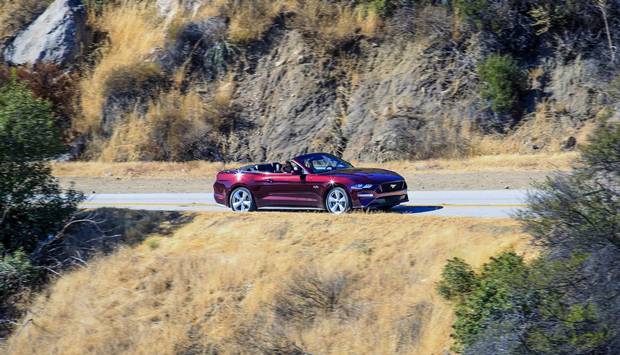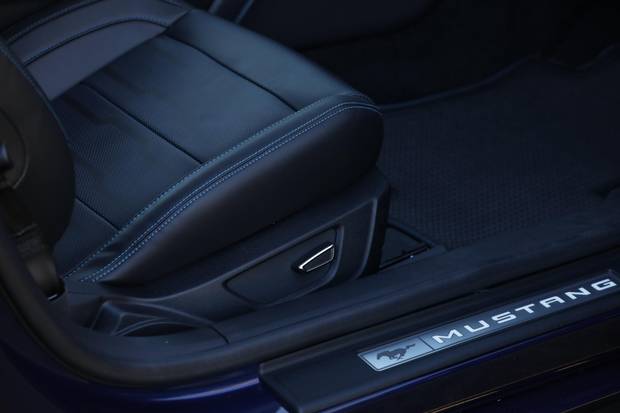The roads in Southern California are among the best in the world. Head out into the low canyons and they twist and curve through the valleys, climbing and dropping and challenging everything about your vehicle. They're smooth and untouched by frost, and there are frequent pullouts for slower traffic. Except … in California, most drivers never seem to use those pullouts, as we learned test driving the new Ford Mustang.
The car is built for power and agility, but when it's stuck behind an older car – in this case, an Outback – refusing to secede its slower place on the highway, well, that's it. My driving companion behind the Mustang's wheel could barely believe this predicament. A ripe thesaurus of Québécois vernacular burst out as the Outback stayed resolutely on its lumbering path into the mountains. We were well below the speed limit and patience would definitely have been a virtue.
We drove for some distance before finally pulling off onto another canyon road where the Mustang could open up and stretch its new legs.
Officially, the 2018 model is a refresh of the all-new car that was released to great fanfare in 2015. There are many changes and differences, though, that are more extensive than the usual makeover that lesser models receive. "This is one of the most aggressive refreshes you'll ever see for a vehicle," says the new Mustang's chief engineer, Carl Widmann.

The new Mustang comes with a choice between the 460-horsepower, 5.0-litre V-8 or 2.3-litre four-cylinder EcoBoost.
There's no more V-6, for example, but just a choice between the 460-horsepower, 5.0-litre V-8 (up 25 hp from last year) or the 310-hp 2.3-litre four-cylinder EcoBoost that's also found in the Focus RS. What you really need to know is the smaller engine makes an impressive 350 lbs.-ft. of torque, which is 30 more than last year's EcoBoost.
There's a 10-speed automatic transmission with paddle shifters to replace the previous six-speed (a $1,500 option over the six-speed manual), and both transmissions have much heftier clutches to handle the extra power. The V-8 now has direct fuel injection with 16 injectors, not just eight. "It shoots atomized fuel out of a direct injector, so you get a better burn because the fuel's already been atomized," says Widmann, who loves being able to explain this stuff. "If you get a better burn, you can increase the compression ratio. It goes from 11:1 to 12:1, and I get power out of that, and fuel efficiency out of that."
There's more, like the new manifolds and re-ported head and the spray-bore technology taken from the Shelbys, but it's clear this is more than just a few tweaks here and there.

Ford says the car can go from zero to 100 km/h in less than four seconds with the V-8.
Even the shape of the car is a little different. The hood is 25 mm lower at the front, for smoother aerodynamics, and the hood vents are now safe in the rest of the world for meeting pedestrian-protection legislation – until today, Mustangs couldn't be exported with hood vents.
Most drivers, though, will be most impressed with the new digital gauges that swap their appearance between the various driving modes. They were designed by engineers but also by video gamers. For example, when you activate "line-lock" so the front wheels are braked but the rear wheels are allowed to spin for a big-time smoke-out (now available with both engines, not just the V-8), there's an icon on the instrument cluster that shows a spinning wheel and a whole pile of obscuring smoke.
Finally, virtual reality crosses into the real world. So do the consequences: try this on a public road and you'll probably lose your licence for stunting.
Normally, I'd be content with the less powerful car for driving on public roads, but the V-8 has an ace up its sprayed-on cylinder sleeves. Its exhaust can be easily set to any of four different sound levels, from Quiet to Track, and they're progressively louder and more crackly. "We wanted Track to be as far as we could push the limits and still be legal," says Widmann.
The V-8’s exhaust can be set to four different sound levels.
Other cars, such as Jaguar F-Types, have buttons for a louder exhaust, but the Mustang doesn't stop there. It has a "good neighbour" function so the driver can set the exhaust to default to Quiet at specific times of day, such as early morning. Clearly, these engineers live in the Detroit 'burbs, and Widmann proves this. "I drive in Sport mode usually," he says, "but I set the timer so that when I start the car in my little area of suburbia I don't blow my neighbours out of their beds."
How considerate. If only California drivers were so thoughtful of others. "How's the car handling?" asked my co-driver as I swept through the fast curves of the perfectly cambered canyon road. He'd driven for an hour but had no idea of the Mustang's potential.
In truth, it felt as capable as last year's model, which is still very capable indeed. On paper, it's a bit quicker, with Ford claiming a zero-to-100 km/h time of "less than four seconds" for the V-8 and "less than five seconds" for the EcoBoost.
It's not just the ride these days on our more congested streets. It's the image, and the Mustang is a surprisingly refined vehicle for a car that starts at $28,888 for the base EcoBoost coupe and pegs out at $52,738 for the GT convertible. And it's also just the promise of being able to deliver, should you call on it. The little spinning-wheel icon and crackly exhaust are only a couple of button presses away. Just be careful where you use them, especially if you live in the 'burbs.
Tech specs
- Base price/As tested: $28,888 / $47,188, plus $1,750 destination and delivery
- Engine: 2.3-litre inline-4 turbocharged EcoBoost; 5.0-litre V-8
- Transmission/Drive: six-speed manual or 10-speed automatic
- Fuel economy (litres/100 km): 2.3-litre manual: 11.0 city, 7.7 highway, 9.5 combined; 5.0-litre automatic: 15.1 city, 9.3 highway., 12.5 combined
- Alternatives: Chevrolet Camaro, Dodge Challenger
Looks
Even snarlier, with that lower hood and those squinting headlights, which are redesigned and all-LED for 2018.

The cabin has a classier look, with ‘satin aluminum’ replacing the chrome brightwork.
Interior
Surprisingly refined for a performance car. Ford spent a lot of time finessing the cabin to give it a classier look. Much of the chrome brightwork, for example, is now replaced with "satin aluminum" for a higher-end appeal without greater cost.
Performance
More power and slightly better fuel consumption – what's not to like?
Technology
The next generation of Ford's Sync 3 system for staying connected, plus 2,000 design hours of fiddling with the gauges, are all finally paying off.
Cargo
No different from before, and still cramped in the back seat. Not your problem though, eh?
The Verdict
9
A solid improvement to an iconic car.
The writer was a guest of the auto maker. Content was not subject to approval.
Shopping for a new car? Check out the new Globe Drive Build and Price Tool to see the latest discounts, rebates and rates on new cars, trucks and SUVs. Click here to get your price.
